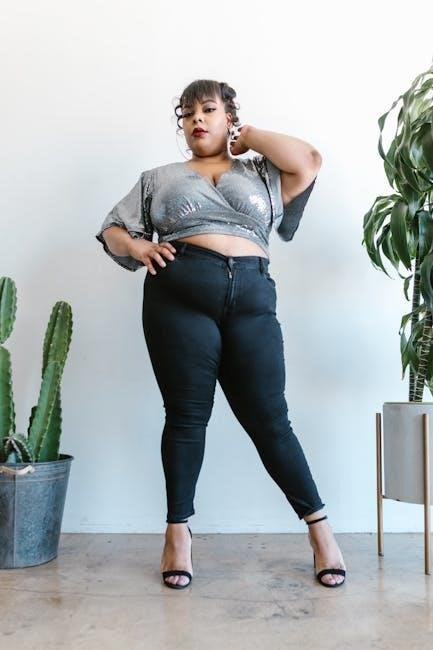
Finding the perfect fit for women’s trousers in the UK can sometimes feel like navigating a maze. This comprehensive guide aims to simplify the process‚ providing valuable information and tools. From understanding UK sizing nuances to measuring yourself accurately‚ we’ve got you covered.
Navigating the world of UK women’s trouser sizing can be a perplexing experience. Unlike some standardized systems‚ UK sizes can vary significantly between different retailers and brands. This inconsistency often leaves shoppers feeling frustrated and unsure about which size to choose.
The purpose of this guide is to demystify the UK women’s trouser sizing system and provide you with the knowledge and tools necessary to find trousers that fit you perfectly. We’ll explore the key measurements that determine trouser size‚ including waist‚ hip‚ and inside leg. We’ll also delve into the common discrepancies and provide tips for accurately measuring yourself at home.
Furthermore‚ we’ll provide size charts that can serve as a general reference point‚ while also emphasizing the importance of checking specific brand size guides whenever possible. By understanding the nuances of UK sizing and taking accurate measurements‚ you can confidently shop for trousers online or in-store‚ knowing that you’re making an informed decision.
Ultimately‚ our goal is to empower you to find trousers that not only fit well but also make you feel comfortable and confident.
How to Measure Yourself for Trousers
Accurate self-measurement is crucial for finding the right trouser size‚ especially when shopping online. To get started‚ gather a flexible measuring tape‚ a full-length mirror‚ and ideally‚ a friend to assist you. Wear lightweight clothing or undergarments to ensure the most accurate measurements.
Begin by measuring your waist. Stand straight and locate your natural waistline‚ which is usually the narrowest part of your torso. Wrap the measuring tape around your waist‚ ensuring it’s parallel to the floor and snug but not too tight. Record the measurement in both inches and centimeters.
Next‚ measure your hips. Stand with your feet together and find the fullest part of your hips and buttocks. Wrap the measuring tape around this area‚ keeping it level. Again‚ record the measurement in both inches and centimeters.
Finally‚ measure your inside leg. Stand with your feet slightly apart and measure from your crotch down to where you want the hem of your trousers to fall. This is typically around your ankle bone. If you plan to wear the trousers with heels‚ wear them during the measurement. Record this measurement as well.

Remember to take each measurement two or three times to ensure accuracy. If you’re unsure‚ it’s always better to err on the side of a slightly larger size.
Waist Measurement Guide
Achieving an accurate waist measurement is paramount when selecting trousers‚ as it directly influences the fit and comfort around your midsection. The waist measurement determines how the trousers sit on your body‚ preventing them from being too tight or too loose.
To begin‚ stand naturally and breathe normally. Locate your natural waistline‚ which is the narrowest part of your torso‚ usually just above your belly button. Avoid sucking in your stomach‚ as this will result in an inaccurate measurement. Wrap the measuring tape around your waist‚ ensuring it is parallel to the floor.
The tape should be snug but not constricting. You should be able to comfortably place a finger between the tape and your skin. Note the measurement where the tape overlaps‚ ensuring that the tape is not twisted or creased.
Record your waist measurement in both inches and centimeters for easy reference when consulting size charts. It’s helpful to take the measurement a few times to confirm its accuracy. Any slight variations can be averaged out to determine your true waist size.
Keep in mind that waist sizes can vary slightly between brands‚ so always refer to the specific size chart provided by the retailer or manufacturer. A well-taken waist measurement will ensure a comfortable and flattering fit for your trousers.
Hip Measurement Guide
Measuring your hips accurately is crucial for ensuring a proper fit in trousers‚ particularly around the seat and upper thigh area. Incorrect hip measurements can lead to trousers that are either too tight‚ restricting movement‚ or too loose‚ resulting in an unflattering silhouette. This guide provides a clear and simple method for obtaining your hip measurement.
Start by standing with your feet together on a level surface. It’s best to wear thin clothing or undergarments to avoid adding extra bulk to the measurement. Locate the fullest part of your hips and buttocks. This is usually a few inches below your waistline.
Wrap the measuring tape around your hips‚ ensuring that it passes over the fullest part of your buttocks and that the tape is parallel to the floor. The tape should be snug but not too tight‚ allowing for comfortable movement. Avoid pulling the tape too tightly‚ as this will compress your body and result in an inaccurate measurement.
Note the measurement where the tape overlaps‚ making sure the tape is straight and not twisted. Record the measurement in both inches and centimeters for easy comparison with size charts. It’s advisable to repeat the measurement a couple of times to ensure consistency.
Remember that hip sizes can vary among different brands‚ so always refer to the specific size chart provided by the retailer or manufacturer. Taking an accurate hip measurement will help you select trousers that fit comfortably and flatter your figure.
Inside Leg Measurement Guide
The inside leg measurement‚ also known as inseam‚ determines the length of your trousers and ensures they fall correctly on your legs. An accurate inside leg measurement prevents trousers from being too short‚ exposing your ankles awkwardly‚ or too long‚ dragging on the floor and becoming damaged. Here’s how to measure your inside leg:
For the most accurate result‚ ask a friend to help you with this measurement. Stand straight with your feet shoulder-width apart on a flat surface. Wear the shoes you’ll typically wear with the trousers you plan to purchase‚ as shoe height affects the required length.
Your friend should measure from your crotch‚ where the inside of your leg begins‚ down to where you want the hem of your trousers to fall. This is typically just below your ankle bone or at the top of your shoe. Ensure the measuring tape is straight and follows the inside seam of your leg.
If you’re measuring yourself‚ stand against a wall and use a long ruler or measuring tape. Place the end of the tape at your crotch and measure down to your desired hem point. It can be challenging to get an accurate reading this way‚ so take your time and double-check your measurement.
Record the measurement in both inches and centimeters. Many retailers offer trousers in various inside leg lengths‚ so having this measurement will help you choose the correct size. If you’re between sizes‚ it’s often better to opt for the longer length‚ as you can always have trousers hemmed to a shorter length.
UK Size Chart for Women’s Trousers
Navigating UK sizing for women’s trousers can be tricky‚ as sizes can vary between brands. A UK size chart provides a standardized reference point‚ helping you translate your measurements into the corresponding UK size. However‚ remember that these charts are general guidelines‚ and it’s always best to check the specific size chart provided by the retailer.
A typical UK size chart for women’s trousers includes key measurements such as waist and hip circumference. Some charts may also include inside leg length‚ particularly for jeans and tailored trousers.
To use a UK size chart effectively‚ start by taking your waist and hip measurements using a flexible measuring tape. Ensure the tape is snug but not too tight‚ and measure over your bare skin or thin clothing for the most accurate results.
Once you have your measurements‚ compare them to the size chart. Find the row where your waist and hip measurements fall within the specified range. The corresponding UK size in that row is likely your best fit.

Keep in mind that some charts may use numerical sizes (e.g.‚ 8‚ 10‚ 12) while others use letter sizes (e.g.‚ XS‚ S‚ M). Familiarize yourself with the chart’s format before making your selection.
If your measurements fall between two sizes‚ consider the style of the trousers. For fitted trousers‚ you may want to choose the smaller size. For looser-fitting trousers‚ the larger size may be more comfortable. When in doubt‚ it’s always a good idea to read customer reviews or contact the retailer for sizing advice.
International Size Conversions (UK to US‚ EU)
Shopping for women’s trousers from international brands can be confusing due to differing size systems. Converting UK sizes to US or EU sizes is crucial for ensuring a proper fit. However‚ it’s essential to remember that these conversions are approximate‚ and variations may occur between brands.
Generally‚ a UK size is smaller than its US equivalent. For example‚ a UK size 8 is roughly equivalent to a US size 4. Similarly‚ UK sizes differ from EU sizes. A UK size 8 typically corresponds to an EU size 36.
Online resources and size conversion charts can provide a helpful starting point. These charts usually list UK sizes alongside their corresponding US and EU sizes for women’s trousers. However‚ it’s always advisable to consult the specific brand’s size chart for more accurate guidance.
When converting sizes‚ consider your body measurements. If your waist and hip measurements fall between two sizes in the conversion chart‚ opt for the larger size for a more comfortable fit.
Keep in mind that sizing can vary depending on the style of the trousers. For example‚ skinny jeans may fit differently than wide-leg trousers‚ so it’s always best to check the product description for specific sizing recommendations.
If you’re unsure about the correct size‚ consider ordering multiple sizes and returning the ones that don’t fit. This can be a convenient way to ensure you find the perfect pair of trousers‚ especially when shopping online.
Plus Size Trousers Size Chart UK
Finding well-fitting plus size trousers in the UK requires understanding specific size charts. Plus size trousers are designed to accommodate curvier figures‚ offering more room in the waist‚ hips‚ and thighs.

UK plus sizes typically start around size 16 or 18‚ though this can vary between brands. A plus size chart will provide measurements for waist‚ hips‚ and inside leg length‚ allowing you to find the best fit for your body shape. It’s crucial to measure yourself accurately and compare your measurements to the chart before making a purchase.
Plus size trousers often feature design elements that enhance comfort and fit‚ such as elasticated waistbands‚ higher rises‚ and stretch fabrics. These features can make a significant difference in how the trousers feel and look on your body.
When using a plus size chart‚ pay close attention to the brand’s specific measurements. Sizing can vary between retailers‚ so a size 20 in one brand may not be the same as a size 20 in another.
Consider the style of the trousers when choosing a size. For example‚ wide-leg trousers may require a different fit than skinny jeans. Read product reviews to see if other customers have commented on the sizing accuracy of the trousers you’re interested in.
Don’t hesitate to contact the retailer’s customer service team if you have any questions about sizing. They can provide personalized advice and help you find the perfect fit.
Tips for Finding the Right Fit When Shopping Online
Shopping for trousers online can be convenient‚ but it also presents unique challenges in ensuring a proper fit. Here are some tips to help you navigate the online shopping experience and find trousers that flatter your figure.
Know Your Measurements: Before you start browsing‚ take accurate measurements of your waist‚ hips‚ and inside leg; Refer to the brand’s size chart and compare your measurements to the corresponding sizes.
Read Size Charts Carefully: Each brand has its own size chart‚ so don’t assume that your usual size will fit. Pay attention to the specific measurements provided and choose the size that best matches your body.
Check Customer Reviews: Customer reviews can provide valuable insights into the fit of the trousers. Look for comments about whether the trousers run true to size‚ are too big‚ or too small.
Understand Fabric and Style: Consider the fabric and style of the trousers. Stretchy fabrics may offer more flexibility in sizing‚ while structured fabrics may require a more precise fit.
Utilize Virtual Fitting Tools: Some online retailers offer virtual fitting tools that use your measurements and body shape to recommend the best size.
Order Multiple Sizes: If you’re unsure about your size‚ consider ordering two sizes and returning the one that doesn’t fit.
Check Return Policies: Before making a purchase‚ make sure the retailer has a clear and easy return policy.
Pay Attention to Details: Look closely at the product photos and descriptions.
Caring for Your Trousers to Maintain Size and Shape
Proper care is essential to prolong the life of your trousers and maintain their original size and shape. Here are some tips to help you care for your trousers:
Read the Care Label: Always follow the instructions on the care label. This will provide specific guidance on washing‚ drying‚ and ironing your trousers.
Wash Inside Out: Washing your trousers inside out can help prevent fading and protect the fabric from abrasion;
Use a Gentle Detergent: Use a mild detergent that is designed for delicate fabrics. Avoid using harsh chemicals or bleach‚ as these can damage the fabric and cause it to shrink or stretch.
Wash in Cold Water: Washing your trousers in cold water can help prevent shrinking and fading. Hot water can cause the fabric to break down and lose its shape.
Avoid Overloading the Washing Machine: Overloading the washing machine can prevent the trousers from being cleaned properly and can also cause them to become misshapen.
Tumble Dry on Low Heat or Air Dry: Tumble drying can cause the trousers to shrink‚ so it’s best to tumble dry on low heat or air dry them. If you choose to tumble dry‚ remove the trousers from the dryer while they are still slightly damp and hang them up to finish drying.
Iron on Low Heat: Iron your trousers on low heat to avoid scorching the fabric.
Store Properly: Store your trousers in a cool‚ dry place.
